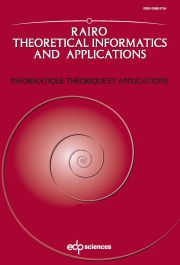Article contents
On the number of dissimilar pfaffian orientations of graphs
Published online by Cambridge University Press: 15 March 2005
Abstract
A subgraph H of a graph G is conformal if G - V(H) has aperfect matching. An orientation D of G is Pfaffian if, forevery conformal even circuit C, the number of edges of C whosedirections in D agree with any prescribed sense of orientation ofC is odd. A graph is Pfaffian if it has a Pfaffianorientation. Not every graph is Pfaffian. However, if G has aPfaffian orientation D, then the determinant of the adjacency matrixof D is the square of the number of perfect matchings of G. (Seethe book by Lovász and Plummer [Matching Theory. Annals of Discrete Mathematics, vol. 9. Elsevier Science (1986), Chap. 8.]A matching covered graph is a nontrivial connected graph inwhich every edge is in some perfect matching. The study of Pfaffianorientations of graphs can be naturally reduced to matching coveredgraphs. The properties of matching covered graphs are thus helpful inunderstanding Pfaffian orientations of graphs. For example, say thattwo orientations of a graph are similar if one can be obtainedfrom the other by reversing the orientations of all the edges in a cutof the graph. Using one of the theorems we proved in [M.H. de Carvalho, C.L. Lucchesi and U.S.R. Murty, Optimal ear decompositions of matching covered graphs. J. Combinat. Theory B85 (2002) 59–93]concerning optimal ear decompositions, we show that if a matchingcovered graph is Pfaffian then the number of dissimilar Pfaffianorientations of G is 2b(G) , where b(G) is the number of“bricks” of G. In particular, any two Pfaffian orientations of abipartite graph are similar. We deduce that the problem ofdetermining whether or not a graph is Pfaffian is as difficult as theproblem of determining whether or not a given orientation is Pfaffian,a result first proved by Vazirani and Yanakakis [Pfaffian orientation of graphs, 0,1 permanents, and even cycles in digraphs.Discrete Appl. Math.25 (1989) 179–180].We establish a simple property of minimal graphs without a Pfaffianorientation and use it to give an alternative proof of thecharacterization of Pfaffian bipartite graphs due to Little [ A characterization of convertible (0,1)-matrices.J. Combinat. Theory B18 (1975) 187–208] .
Information
- Type
- Research Article
- Information
- RAIRO - Theoretical Informatics and Applications , Volume 39 , Issue 1: Imre Simon, the tropical computer scientist , January 2005 , pp. 93 - 113
- Copyright
- © EDP Sciences, 2005
References
- 7
- Cited by

